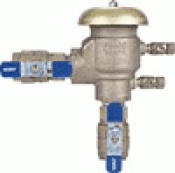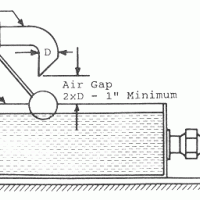Cross Connection Control
In 1989 Lakewood Water District began its Cross Connection Control Program to comply with The State of Washington Health Department’s WAC 246-290-490.
The program began modestly back in 1989. The District began inspecting high hazards such as hospitals, dry cleaners, dentists, and other commercial customers. By 1990 we began inspecting new existing home irrigation systems.
A cross connection is a point in the plumbing system where the public potable water supply is connected directly, or has the potential of being connected, to a source of non-potable substance that is not part of the public potable water supply. An example would be that potable water enters a building. The water is used to feed a soda dispenser in a restaurant. The water becomes contaminated or polluted with CO2 and the water travels into piping feeding a sink. If someone were to drink this water they could become ill. The way The District prevents this is to have the customer install a backflow prevention assembly that is rated for the degree of hazard for a given situation. If water does start to travel back through the piping it is stopped by a series of check valves that will contain the problem.
There are two ways that backflow problems can occur. One way is backpressure and the other is backsiphonage.
Lakewood Water District has completed all its existing high hazard inspections. We are currently working on existing home irrigation systems, new construction, and other lower hazard commercial and industrial businesses.
“At the current time we have over 5,000 backflow valves protecting the citizens of Lakewood Water District. Each valve is required to be tested annually, by the owner, to make sure it operates properly according to State requirements.”
The Cross Connection Control Program at the Lakewood Water District is one of the most respected and efficient in the State of Washington. The District sat on a committee that helped The State Health Department rewrite the WAC for the program last year. There have been only two backflow incidents that have been recorded in the district in the past ten years.
High Hazard – A physical or toxic hazard which could be detrimental to ones health.
Low Hazard – A hazard which could cause aesthetic problems or have a detrimental effect on the quality of the public potable water supply.
Potable Water – Water which is safe for human consumption, free from harmful or objectionable materials.
Non-potable Substance – Any water or substance which is not safe for human consumption, or is not a part of the public potable water supply.
Contaminated – An impairment of the potable water which creates an actual hazard to the public health through poisoning or through the spread of diseases by sewage, industrial fluids or waste. Also defined as high hazard.
Polluted – An impairment of the quality of the public potable water supply which does not create a hazard to the public health but which does adversely affect the aesthetic qualities of such potable waters for domestic use. Also defined as low hazard.
Backflow Prevention Assembly – An assembly which prevents the backflow of water or other liquids, gases or solids into the purveyor’s potable water supply and appears on the health authority “Approved” list.
Backpressure – Water pressure which exceeds the operating pressure of the public potable water supply.
Backsiphonage – Backflow due to a negative or reduced pressure within the public potable water supply.
Types of Backflow Prevention Devices
Pictures are for Illustration purposes only

DCVA – Double Check Valve Assembly / Protection for lower hazards, such as irrigation systems.

RPBA – Reduced Pressure Backflow Assembly / Protection for high hazards, such as boilers, x-ray machines, soda dispensers, etc.

PVBA – Pressure Vacuum Breaker Assembly / Protection for lower hazards, such as irrigation systems.

